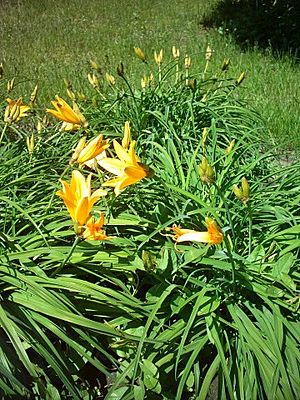Hemerocallis middendorffii facts for kids
Quick facts for kids Hemerocallis middendorffii |
|
|---|---|
 |
|
| Hemerocallis middendorffii var. middendorffii | |
| Scientific classification |
The Hemerocallis middendorffii, also known as the Amur daylily, is a beautiful flowering plant. It belongs to a group of plants called Asphodelaceae. This plant is originally from places like the Russian Far East, northwest China, Korea, and Japan. You can find it growing in meadows, on mountain slopes, in open woods, and in bushy areas. In Asia, people grow this daylily because its flowers can be eaten!
What Does the Amur Daylily Look Like?
The Amur daylily is a perennial plant, which means it lives for more than two years. It has long, arching leaves that can grow up to 60 centimeters (about 2 feet) long. Its flower stems, called scapes, can reach between 20 and 90 centimeters (about 8 inches to 3 feet) tall.
The plant usually has 5 to 6 golden yellow or bright orange flowers. These large flowers grow in a cluster at the top of the stem. They bloom in July for about two to three weeks. Sometimes, they even bloom again in September!
There are four main types, or varieties, of the Amur daylily:
- H. middendorffii var. middendorfii: This type can grow up to 90 centimeters (about 3 feet) tall. Its orange flowers do not have a smell.
- H. middendorffii var. esculenta: This variety is found in Japan.
- H. middendorffii var. exaltata: This type also grows in Japan.
- H. middendorffii var. longibracteata: This smaller type grows to 20 to 35 centimeters (about 8 to 14 inches) tall. Its yellow flowers are fragrant, meaning they smell nice. This variety is only found in China.
Growing Amur Daylilies
The Amur daylily is quite easy to grow. It likes moist soil and a sunny spot. However, it can also grow well in poor soil and places with some shade.
You can grow new plants by dividing an existing plant or by planting seeds. If you plant seeds, it usually takes about two to three years for the plant to produce flowers.
These plants prefer soil that is neutral or slightly acidic. They might not grow as well in very acidic or very alkaline soils. Luckily, Amur daylilies usually don't have many problems with pests or diseases. They are also very tough and can survive cold winters, even in areas as cold as USDA zone 4.
See also
 In Spanish: Hemerocallis middendorffii para niños
In Spanish: Hemerocallis middendorffii para niños

